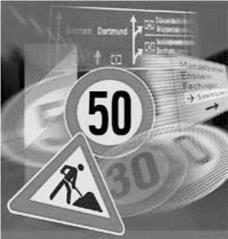Traffic signs and devices must be highly visible and legible to clearly alert and inform drivers in time. High-quality traffic signs can contribute to meeting the higher road safety needs arising from a traffic volume that has drastically increased in recent years. Especially in urban traffic conditions, traffic participants are blinded or distracted by extraneous lights, and the number of elderly traffic participants with visual impairment has steadily increased.
Self-adhesive retroreflective sheeting allows information to be safely communicated in time, even in adverse weather conditions, owing to high retroreflective
|
Figure 8.72 Traffic signs with reflecting foils. |
performance (Figure 8.72). Scientific studies and national and international field tests have shown that carefully placed high-quality traffic signs also significantly enhance traffic safety.
Fluorescent yellow traffic signs are eye-catchers and help to avoid accidents. In Germany, each day, many traffic accidents occur at poorly marked danger spots. For example, over half of the total 25 000 railroad crossings are marked only by a conventional St. Andrew’s cross; this is supposed to warn the road users but it does not — one in four of the accidents that occur at railroad crossings leads to fatalities (74 in the year 2000 alone). But many dramatic accidents also happen at construction sites and schools. In Germany in 2001, 106 schoolchildren were killed outside their school building. National and international studies have demonstrated that fluorescent yellow sheeting significantly increase the visibility of traffic signs, and the German automobile club, ADAC, has called for their use at railroad crossings.
Self-adhesive reflective sheeting for traffic signs are applied by rubber rollers, print rolls or knives to aluminum alloy or plastic surfaces. When using plastics as application surfaces, the applications should be evaluated to ensure acceptable adhesion. Although adhesion promotion by primers is not necessary, it is advantageous to slightly roughen the sheets such that their surfaces are absolutely clean, dry and free of grease immediately prior to bonding, which is performed at a temperature of at least 18 ° C. Raising the temperature to 25 °C leads to an increase in the initial adhesion capacity of the sheeting.
8.12.2
 10 января, 2016
10 января, 2016  Pokraskin
Pokraskin 
 Опубликовано в рубрике
Опубликовано в рубрике 